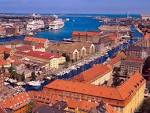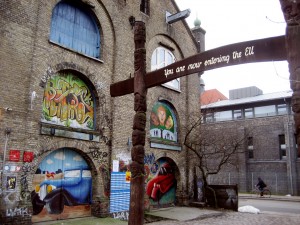
![]()
Welcome • |
About
Us • |
The International Writers Magazine: Europe
• Colin Todhunter
Never go to Copenhagen! If you hate great architecture, never visit. If you despise lovely canals, don’t bother. And if you can’t abide intimate restaurants and cosy bars, friendly people or seeing urban Scandinaviaat its very best, then stay at home. In other words, you’d be crazy not to want to visit this city.
It’s for good reason that in 2013 Copenhagen topped a list of best cities in the world to live in. It won the award from British-based ‘Monocle’ global affairs and lifestyle magazine, which stated that Copenhagen won due to its “world-conquering urban quality of life.”This is a cosmopolitan, capital city, with a small-town ambiance. And as a city that boasts its fair share of fairytale palaces, churches and medieval buildings, what better way to begin than with a fairytale? The Little Mermaid is probably the city’s most famous tourist attraction. Like Copenhagen itself, this iconic feature possesses a certain understated allure. She sits just on the fringes of the city centre out in the harbour. The small bronze statue of a mermaid resting on a few rocks may not take your breathe away, but first impressions can be misleading. This particular mermaid is based on a Hans Christian Anderson tale. She fell in love with a prince and did a deal with the Sea Witch whereby she was given legs and the ability to live on land. However, in return the witch took her tongue and beautiful singing voice. It all ended tragically. She never got her man and dissolved to become sea foam.
The plaque next to the statue briefly outlines the story and really brings the monument to life. Only the hard hearted could fail to be moved by the story. In the local tourist board’s version of the tale, since 1913 (when the statue was erected) she has been swimming to the harbourside each day to rest on the rock for a glimpse of her prince.
Hans Christian Anderson aside, Copenhagen is sprinkled with lovely old squares, churches and imperious looking buildings that could well have stepped out of a fairytale. One of the most impressive constructions is Fredrick’s Church. Designed in 1740, it boasts Scandinavia’s largest church dome. Then there are the impressive Neo-baroque-style parliament buildings, known as Christiansborg Palace, as well as the beautiful Amalienborg Palace, which is the Royal Family’s winter residence, and various picturesque lakes and canals.
The best waterway is Nyhaven (new harbour) which, along with The Little Mermaid, also frequently appears in images of the city. Nyhaven used to be a gritty port area, where Hans Christian Anderson once lived. Now its home to old-fashioned sailing ships with towering masts and city-tour boats for visitors. The colourful, centuries’ old quaint buildings along the quayside are among some of Copenhagen’s most photogenic buildings, and the outdoor bars and restaurants at ground level are great for hanging out.
And if you do decide hang out there, or anywhere else in the city, why not sample the traditional Danish open-faced sandwich or ‘smørrebrød’? It comprises pieces of meat or fish or paste (often liver), salad dressings and cheese on buttered rye bread and decorated with various toppings. After finishing you can wash it down with a cold Danish Tuborg beer and snaps.
From there, you might want to venture into the city’s student quarter. It’s an area of narrow lanes, homely wood-furnished bars, good eateries and well-preserved medieval architecture. In winter, when the snow is falling (and it will… lots of it!), there can be no better place than to go to one of these small, old-world bars and huddle together around a fire, while watching the city being coated in a blanket of white.Copenhagen is big on fashion, culture, natural beauty and international cuisine and much of the city centre is as affluent as it is well-heeled, as beautiful as it is chic. It is also big on cycling. Cyclists are everywhere and cycle lanes are meticulously laid out. Water is also big in Copenhagen. In summer, the city’s residents enjoy swimming in the harbour, dining at canalside restaurants and picnicking by the side of the various lakes.
But if after a while you feel that Copenhagen is a bit too clean cut, why not venture into Christiania? In the 1960s, a rebellion by young people who were disillusioned with consumerism took hold. Student protests broke out on the university campus and squatters occupied vacant buildings around the city. This culminated in 1971 when protesters tore down the fence of an abandoned military camp and occupied of the site. They called the settlement Christiania. Today, this ‘alternative community’ houses around 900 residents. Walk through the district and you’ll encounter numerous coffee shops, bars and outlets selling hash (on Pusher Street), Goa-type hippie clothing and ornaments and knick-knacks to decorate your home with.
The community has had its fair share of controversy over the years, not least those related to the selling of cannabis and outsiders attempting to corner the trade, but not one person that I spoke to in Copenhagen had a bad word to say about it. Self-governing, the community still seems to adhere in principle and practice to the original ethos. To the casual visitor, with its colourful murals, signs saying ‘no photos’, performing outdoor musicians and open attitude to cannabis, Christiania may at first glance appear to be a theme park that attracts hoards of visitors from the rest of the city. But it’s not. It is a living, breathing community of dedicated individuals who reject the mainstream and try as much as possible to offer the possibility for living differently.
While Copenhagen began as a harbourside village, it now has the trappings of a capital city. But, unlike Paris or London, for example, it’s not a huge city and despite its apparent affluence, it is unpretentious and down to earth. Where in the world would you encounter such tolerance and open-mindedness? That a place like Christiania exists right in the middle of the city says a good deal about the Danes.
I finished my visit by walking past Tivoli Gardens, the renowned amusement park, which is right in the centre, and into the old ‘meat packing’ district of the city to visit a friend. A former workers' area, it’s now an upcoming location that houses ‘creative industries’, galleries, bars and other small enterprises. In my friend’s apartment, I was treated to genuine Danish hospitality by being served delicious homemade rhubarb crumble and fine tasting organic coffee by my host, who first recommended the city to me back in 2002. It took me 12 years to get there! As I watched the foam nestling on my coffee, I was reminded of the tragic Little Mermaid turning to sea foam. She disappeared and faded away, just as I was about to - but by more conventional means - on a plane. Yet she still sits in the harbour. She’s lucky. She gets to stay in Copenhagen. Like my friend, she gets to live there.
And that’s the beauty of Copenhagen - the liveability factor. Denmark itself always tends to top or come pretty close to topping global ‘happiness surveys’ and ‘quality of life’ tables. This comes as no surprise if Copenhagen is anything to go by. Perhaps it’s not a must-see city, in terms of out and out spectacular sights. It’s more of a must-live in city due to the ambiance, the people and the overall quality of the city. For that reason alone, it’s a great place to visit.© Colin Todhunter May 2014
Postcard from Ghent
Colin Todhunter
Leaving India on a very early morning flight out of Cochin and arriving in Ghent in Belgium later on the same day. From a hot December in South India to zero degrees in Europe in a mere 12 hours.
Hack, Slit, Squeal: Immunity in Georgetown, Chennai
Colin Todhunter
Hack, slit, slice. Butchery in Georgetown. Peeled, pink goat carcases in fly-ridden, one-room shops




